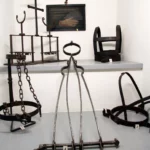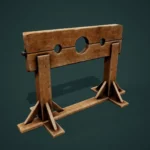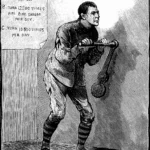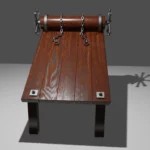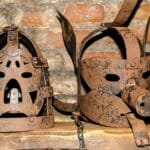Are you ready to venture into the dark abyss of medieval torture? Get ready to uncover the terrifying tools and practices that turned the Middle Ages into a chilling dance of pain and suffering. We’ll take you on a grim journey, exploring the sinister devices that inflicted unimaginable agony on victims, from the bone-crushing rack to the gruesome iron maiden. Prepare yourself for a sobering look into the depths of human cruelty and the resilience that somehow managed to shine through it all.
Medieval Torture: A Grim Reality in History
Imagine yourself living in a time when punishment was brutal and fear permeated society. The Middle Ages were a period when torture was a common method of coercion and punishment.
In those dark times, torture devices were designed to inflict unimaginable pain. The rack, with its ability to stretch a body to its limits, became a staple in the Tower of London. Impalement sticks pierced victims’ bodies, while breaking wheels shattered bones with brutal efficiency.
Medieval torture was not just confined to criminals. Heretics who dared to challenge religious beliefs often faced the torment of these devices. The purpose of torture was to extract confessions, deter crime, and supposedly purify the soul.
However, modern scholars have questioned the authenticity of some rumored torture devices, like the Iron Maiden. It’s now believed that these gruesome contraptions were likely exaggerated or never existed.
Common Torture Devices
| Device | Description |
|---|---|
| The Rack | Stretching device that agonizingly pulled limbs apart |
| Impalement Sticks | Sharp objects thrust through the body |
| Breaking Wheels | Crushing device that shattered bones |
Despite its horrors, medieval torture was seen as a necessary evil. People believed that the pain would deter crime, extract confessions, and purify the soul. But history tells us that such brutality often led to coerced confessions, fear, and injustice.
Remember:
- Torture is not a fair or effective way to extract information or punish criminals.
- It causes excruciating pain and psychological trauma that can last a lifetime.
- No one should be subjected to such inhumane treatment, no matter the crime.
Read about the horrifying medieval torture devices used in the medieval era, which will surely make your skin crawl.
Explore the torture devices throughout history and their gruesome use on prisoners and accused individuals.
Discover the depths of human cruelty through the torture devices medieval times, and delve into the chilling methods used to inflict unimaginable pain.
Uncover the worst torture methods in history, which will shock and horrify you with their sheer brutality and inhumanity.
Learn about the stretching torture device, designed to inflict excruciating pain by tearing the body apart.
How did medieval torture methods evolve over time?
People think medieval torture methods were brutal, but they actually evolved over time to become even more gruesome. This was partly due to societal changes and partly due to technological advancements.
Torture became more widespread during the Medieval Inquisition because of religious extremism and the need for confessions. New torture devices were created, such as the rack, boot, and Breaking Wheel. These were designed to inflict excruciating pain and extract information.
The Rack: A spine-chilling nightmare
Imagine being stretched on a wooden frame while rollers slowly pull your limbs apart. That’s what the rack did. It caused unimaginable pain, often leading to dislocated joints and shattered bones.
The Boot: A leg-crushing horror
Think of a metal cage that encloses your leg. Then imagine wooden wedges being driven into it, crushing your bones and muscles. That’s the boot. The agony was so intense that victims would often pass out or beg for death.
The Breaking Wheel: A slow and gruesome execution
The Breaking Wheel was a cruel device used to inflict a slow and painful death. The victim was tied to a large wheel and their limbs repeatedly broken with a hammer. The shattered bones were then left exposed, causing the victim to suffer for hours before dying.
These are just a few of the many horrific torture methods used in medieval times. As time went on, new devices and techniques emerged, each designed to inflict unimaginable pain and suffering. It’s a reminder of the depths of human cruelty and the importance of protecting human rights.
Were there any ethical concerns about torture in medieval Europe?
Torture was a common practice in medieval Europe. Were there any ethical concerns about it? Not really. It was seen as a necessary evil, an effective way to extract confessions, and a deterrent to crime. In fact, torture was often used without regard to the suspect’s guilt or innocence, and sometimes as a form of punishment.
Why was torture so prevalent in medieval Europe?
There are a few reasons why torture was so prevalent in medieval Europe. First, there was a lack of reliable methods of investigation. Second, the justice system was often corrupt, and torture was seen as a way to get to the truth. Third, there was a widespread belief that physical pain could purge a person of evil.
What were some of the most common torture methods used in medieval Europe?
Some of the most common torture methods used in medieval Europe include:
- The rack: A device that stretched the victim’s limbs until they dislocated.
- Impalement sticks: Sharp sticks that were inserted into the victim’s body.
- The Iron Maiden: A device that crushed the victim’s body.
Were there any ethical concerns about torture in medieval Europe?
As we’ve mentioned, not really. Torture was seen as a necessary evil, and there were no significant ethical concerns about it. However, there were some isolated cases where people spoke out against torture. For example, in the 13th century, a Dominican friar named Thomas Aquinas argued that torture was immoral because it violated the victim’s natural rights.
When did torture begin to decline in Europe?
Torture began to decline in Europe in the 18th century. This was due to a number of factors, including the rise of humanism, the Enlightenment, and the development of more reliable methods of investigation.
What were the psychological effects of torture on its victims?
Torture, a harrowing practice that has left an enduring mark on civilization, has profound and lasting psychological effects on its victims. These effects can linger long after the physical torment has ended and haunt survivors for years to come.
A Toll on the Mind
Torture wreaks havoc on the mental well-being of its targets. Victims may endure years of torment, including:
- PTSD (Post-Traumatic Stress Disorder): A debilitating condition characterized by intrusive thoughts, nightmares, flashbacks, and hypervigilance.
- Depression: A dark cloud that weighs heavily on victims, robbing them of joy and hope.
- Anxiety: A constant state of unease and fear that disrupts daily life.
- Insomnia: Nights filled with fitful sleep, haunted by grim memories.
- Nightmares: Vivid and terrifying dreams that replay the horrors of torture.
- Flashbacks: Uncontrollable and vivid recollections of the torture that can strike at any moment.
- Emotional Numbing: A sense of detachment and emptiness as a coping mechanism.
- Dissociation: Feeling separate from one’s body or surroundings as a way to escape the pain.
- Suicidal Thoughts: The unbearable weight of trauma can lead to thoughts of ending one’s own life.
- Self-Harm: Physical pain as a desperate attempt to cope with the emotional anguish.
Shattering the Self
Beyond the psychological torment, torture also shatters victims’ sense of self and trust. They may feel:
- Shame: As if they’re somehow responsible for the suffering they endured.
- Guilt: An overwhelming burden for having survived while others perished.
- Worthlessness: A deep-seated belief that they have no value or purpose.
- Mistrust: A profound lack of faith in others, even those who care for them.
A Lingering Legacy
The long-term effects of torture can be crippling. Victims may face:
- Inability to work or study: The psychological toll can make it difficult to concentrate or perform daily tasks.
- Relationship difficulties: Trust issues and emotional detachment can strain relationships.
- Increased risk of physical health problems: The stress and trauma of torture can manifest as heart disease, diabetes, and cancer.
A Human Catastrophe
Torture is a heinous act that inflicts unspeakable damage on its victims. It violates human rights and has no place in a civilized society. By understanding the profound psychological effects of torture, we can work together to end this abhorrent practice and provide support to its survivors.
FAQ
Q1: What were some of the most common medieval torture methods?
A1: Medieval torture methods included the rack, impalement sticks, breaking wheels, the boot, rat torture, flaying, thumb screws, dunking, and coffin torture.
Q2: Why was torture so prevalent during the medieval period?
A2: Torture was used in medieval Europe to extract confessions, deter crimes, punish heretics, and identify suspects.
Q3: Were some of the gruesome torture methods, such as the Iron Maiden, actually used?
A3: There is skepticism surrounding the existence of certain gruesome medieval torture methods, including the Iron Maiden. Some historians believe they may have been exaggerated or mythical.
Q4: What were the psychological effects of medieval torture?
A4: Medieval torture often had severe psychological effects on victims, including long-term mental health issues.
Q5: Is torture still practiced today?
A5: Torture is still practiced in some countries around the world, despite international laws prohibiting cruel and unusual punishment.
- Mastering Leader in Spanish: The Complete Guide - April 19, 2025
- Uncovering Surprising Parallels: England Size Compared to US States - April 19, 2025
- Old Mexico Map: Border Shifts 1821-1857 - April 19, 2025

